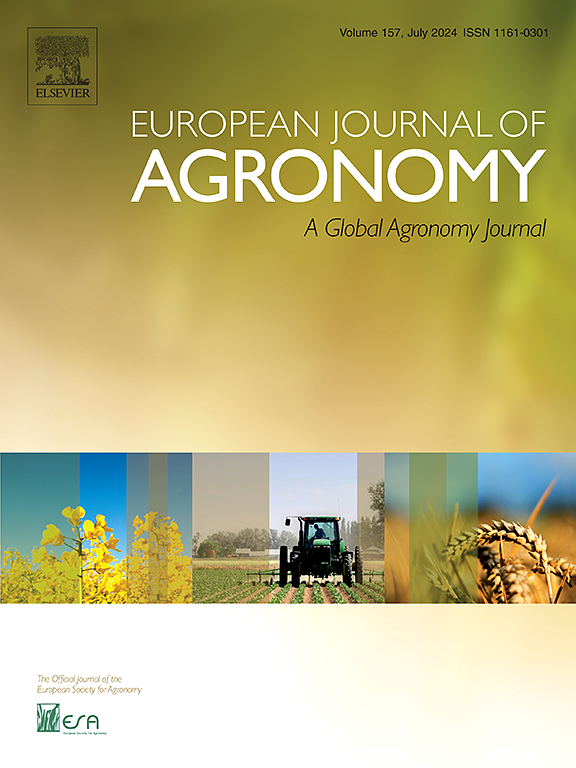Zinc fertilization and bud chip transplanting: Effects on zinc fractions, uptake and sugarcane productivity in calcareous soils
IF 5.5
1区 农林科学
Q1 AGRONOMY
引用次数: 0
Abstract
Sugarcane has tremendous potential to enhance farmers' income; however, micronutrient deficiencies particularly zinc deficiency remain a major constraint in the calcareous soils, which limits sugarcane productivity and nutrient content due to less availability of zinc. A study conducted in Bihar, India over three consecutive years (2019–2022) at the Kalyanpur Farm, RPCAU, Pusa, Samastipur India to evaluate the effects of bud chip transplanting methods and different levels of zinc (Control, 5, 7.5, 10.0 and 12.5 kg ha−1) on the concentration and availability of various zinc fractions in calcareous soil and to assess their contribution to zinc uptake by sugarcane. The conventional planting method significantly improved plant population (160100 ha−1), plant height (302.5 cm), millable canes (115800 ha−1), and cane yield (914 q ha−1) compared to the furrow irrigated raised bed method. Although this method marginally enhanced soil zinc fractions, it did not improve yield. Zinc application had a notable effect on crop performance. The highest zinc dose (12.5 kg ha−1) produced the tallest plants (318.3 cm), highest number of millable canes (123200 ha−1) and maximum cane yield (988 q ha−1). It also increased net assimilation rate, plant zinc concentration (28.82 mg kg−1), zinc uptake (1058 g ha−1) and post-harvest soil zinc availability (0.83 mg kg−1). Economically, application of 12.5 kg zinc ha−1 gave the highest gross return ($ 4103 U.S ha−1), net return ($ 2104 U.S ha−1), and benefit-cost ratio (2.06). Zinc application significantly increased the WSEZn, CAZn, OBZn and RZn in calcareous soil to soil total zinc. However, zinc-use efficiency peaked at 7.5 kg zinc ha−1 (3.15 t cane kg−1 zinc), suggesting diminishing returns at higher doses. The study concludes that conventional planting combined with optimal zinc fertilization in budchip settlings significantly enhances sugarcane productivity and zinc fractions, offering a sustainable strategy for micronutrient management in calcareous soils.
施锌和芽片移栽:对钙质土壤锌组分、吸收和甘蔗生产力的影响
甘蔗增加农民收入的潜力巨大;然而,微量营养素缺乏,特别是锌缺乏,仍然是钙质土壤的主要制约因素,由于锌的可用性较低,限制了甘蔗的生产力和养分含量。在印度比哈尔邦(2019-2022年)连续三年(2019-2022年)在印度Samastipur、Pusa、RPCAU的Kalyanpur农场进行的一项研究,旨在评估芽片移植方法和不同锌水平(对照、5、7.5、10.0和12.5 kg ha−1)对钙质土壤中各种锌组分的浓度和有效性的影响,并评估它们对甘蔗吸收锌的贡献。与沟灌垄作法相比,常规种植方法显著提高了植株数量(160100 ha−1)、株高(302.5 cm)、可蔗量(115800 ha−1)和甘蔗产量(914 q ha−1)。该方法虽然能略微提高土壤锌组分,但不能提高产量。施锌对作物生产性能有显著影响。最高锌剂量(12.5 kg ha−1)可产生最高植株(318.3 cm)、最高蔗数(123200 ha−1)和最高蔗产量(988 q ha−1)。它还提高了净同化率、植株锌浓度(28.82 mg kg−1)、锌吸收量(1058 g ha−1)和收获后土壤锌有效性(0.83 mg kg−1)。经济上,施用12.5 kg锌ha - 1获得最高的总回报(4103美元 U)。S ha - 1),净收益($ 2104 U。S ha−1),效益成本比(2.06)。施锌显著提高了钙质土壤中WSEZn、CAZn、OBZn和RZn对土壤总锌的比值。然而,锌的利用效率在7.5 kg锌ha - 1(3.15 kg锌ha - 1)时达到峰值,表明高剂量的回报递减。研究结果表明,常规种植配以最佳锌肥可显著提高甘蔗生产力和锌组分,为钙质土壤微量元素管理提供了一种可持续的策略。
本文章由计算机程序翻译,如有差异,请以英文原文为准。
求助全文
约1分钟内获得全文
求助全文
来源期刊

European Journal of Agronomy
农林科学-农艺学
CiteScore
8.30
自引率
7.70%
发文量
187
审稿时长
4.5 months
期刊介绍:
The European Journal of Agronomy, the official journal of the European Society for Agronomy, publishes original research papers reporting experimental and theoretical contributions to field-based agronomy and crop science. The journal will consider research at the field level for agricultural, horticultural and tree crops, that uses comprehensive and explanatory approaches. The EJA covers the following topics:
crop physiology
crop production and management including irrigation, fertilization and soil management
agroclimatology and modelling
plant-soil relationships
crop quality and post-harvest physiology
farming and cropping systems
agroecosystems and the environment
crop-weed interactions and management
organic farming
horticultural crops
papers from the European Society for Agronomy bi-annual meetings
In determining the suitability of submitted articles for publication, particular scrutiny is placed on the degree of novelty and significance of the research and the extent to which it adds to existing knowledge in agronomy.
 求助内容:
求助内容: 应助结果提醒方式:
应助结果提醒方式:


